Accepted Scientific Name: Gymnocalycium mihanovichii cv. Hibotan hort.
Katalogname in Schneekloth-Liste
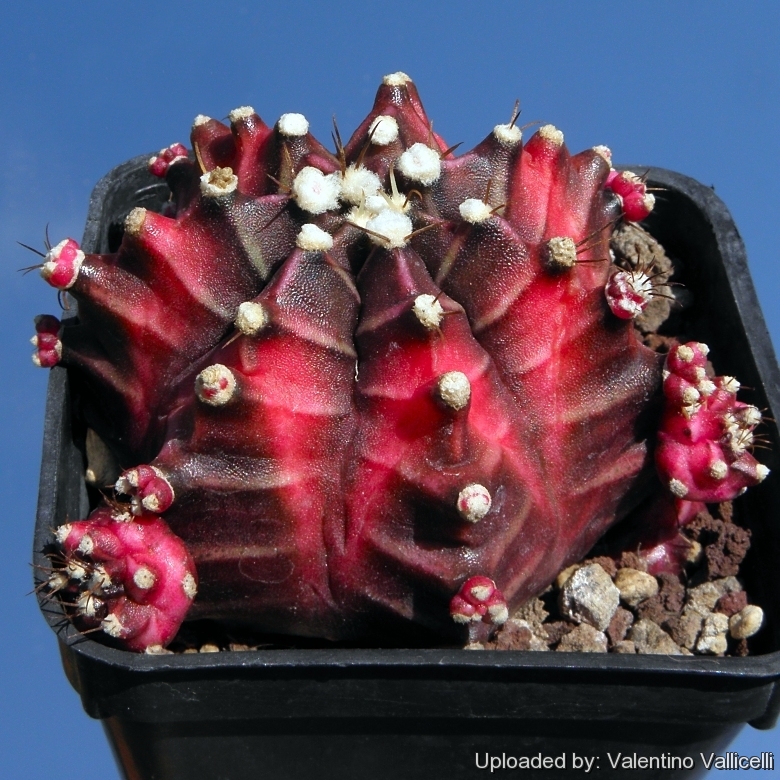
Gymnocalycium mihanovichii var. friedrichii f. Rubra (Gymnocalycium mihanovichii cv. Hibotan) Photo by: Valentino Vallicelli
It is an ensemble of popular mutant with more or less red and banded bodies. Some of this colourful plants (those with some chlorophyll) are able to grow on their own roots and are very priced by collectors.
Origin and Habitat: Garden origin (Nursery produced cultivar)
Synonyms:
See all synonyms of Gymnocalycium mihanovichii
Common Names include:
ENGLISH: Ruby Ball, Red Cap Cactus, Red Hibotan, Hibotan
Description: Gymnocalycium mihanovichiiSN|11932]]SN|11929]] friedrichii 'rubra', or 'Hibotan' comprises a large group of popular mutants, characterized by more or less red coloured bodies. They are red (but also orange, dark purplish, yellow or even white) because they contains few chlorophyll or even no chlorophyll at all, much like the red we see in the fall foliage of trees when their chlorophyll breaks down and disappears. Without chlorophyll many of these mutants gymnocalyciums can not produce sugar and without sugar they will die. The only way to keep them alive is to graft them onto another cactus which has chlorophyll and which will provide sugar to the mutant scion. The chlorophyll containing bottom part of the graft, called the stock, can be any number of different cactus species. In the case of the gymnoclyciums it is usually Hylocereus, a tropical cactus. The oldest and more famous mutant is the bright orange-red and completely chlorophyll-less cultivar "Hibotan" often known as the “Red Cap Cactus”, or “Ruby Ball”. While the yellow and paler forms are sometime known as “Blondie” or “Moon Cactus”.
The first red "HIBOTAN" were produced by E. Watanabe in Japan. Sowing of some thousa Gymnocalycium friedrichiiSN|11929]]SN|11932]] yielded two bright red freak seedlings which would have died quickly had they not been grafted at once. From these have been produced literally millions of plants, distributed all over the world, by repeated grafting and cutting.”
Furthermore a number of variegated cultivars only partially de-coloured are known as "HIBOTAN NISHIKI".
Some of this colourful plants (those with some chlorophyll) are able to grow on their own roots and are very beautiful and priced by collectors.
Stem: Flattened globose to elongated globose, white, yellow, orange, red, greenish-purple, reddish brown to a dark grape colour up to 10 cm tall (or more) and 6-12 cm in diameter, often branching profusely from the sides.
Ribs: 8-14, very prominent, and sharp banded whit strong dark brown markings especially when young, and these sometimes have cross-bands of lighter colours.
Radial spines: 3-6, acicular, to awl shaped, light to dark brown, somewhat twisted, 0,7-1 cm long.
Central spines: Usually absent.
Flowers: Pale-pink to purplish-pink, 6-7 cm long.
Fruits: Gray-green to pinkish-red up to 4 cm long, diameter 1 cm.
Subspecies, varieties, forms and cultivars of plants belonging to the Gymnocalycium mihanovichii/stenopleurum group
The name Gymnocalycium mihanovichii v. friedrichii was introduced by Werdermann in 1936. Pazout suggested the name G. friedrichii nom. inval. in 1964 but it has not been officially approved. In 1979 Ritter made a description of Gymnocalycium stenopleurum that sometimes can be found under the incorrect name G. mihanovichii v. stenopleurum n. n. (don't confuse it with v. stenogonum). Thus we have 3 taxa: "mihanovichii", "friedrichii" and "stenopleurum". Not taking into account their taxonomic definition they are basic points of the complex with many transitional forms between. These three taxa spread from south to north (North-Western Paraguay): The typical "mihanovichii" inhabits the very south of the area – south and south-east of province Boqueron; "stenopleurum" inhabits a limited area on the very north – in Cerro Leon region and has characteristic recognizable habitus; for "friedrichii" all the area between two mentioned points is indicated.
 Gymnocalycium friedrichii (Werderm.) Pazout: Distingushed from Gymnocalycium miahanovichii for the prevalently purplish pink, wide open flowers and well-pronounced polymorphism of spines. Besides it has tall slender ribs and roller-shaped prominent thickening around areoles.
Gymnocalycium friedrichii (Werderm.) Pazout: Distingushed from Gymnocalycium miahanovichii for the prevalently purplish pink, wide open flowers and well-pronounced polymorphism of spines. Besides it has tall slender ribs and roller-shaped prominent thickening around areoles. Gymnocalycium friedrichii f. cristatum hort.: Crested form with nice stems reddish brown to dark grape coloured.
Gymnocalycium friedrichii f. cristatum hort.: Crested form with nice stems reddish brown to dark grape coloured. Gymnocalycium friedrichii var. moserianum Pazout ex Moser: has brown bodies 2 times larger than G. friedrichii, with sharp ribs striped with white, and only 3 weak spines. Flowers are pale pink and open up entirely. Distribution: Yrebdaque, Boquerón, Paraguay.
Gymnocalycium friedrichii var. moserianum Pazout ex Moser: has brown bodies 2 times larger than G. friedrichii, with sharp ribs striped with white, and only 3 weak spines. Flowers are pale pink and open up entirely. Distribution: Yrebdaque, Boquerón, Paraguay. Gymnocalycium mihanovichii (Frič ex Gürke) Britton & Rose: It has wider, lower ribs, in juvenile plants divided into separate chins, in maturity every rib have flat surface and a pleat above each areole. But the essential thing is its pale or brownish-yellow, not fully opening flower.
Gymnocalycium mihanovichii (Frič ex Gürke) Britton & Rose: It has wider, lower ribs, in juvenile plants divided into separate chins, in maturity every rib have flat surface and a pleat above each areole. But the essential thing is its pale or brownish-yellow, not fully opening flower. Gymnocalycium mihanovichii var. filadelfiense Backeb.
Gymnocalycium mihanovichii var. filadelfiense Backeb. Gymnocalycium mihanovichii var. stenogonum Frič & Pazout: has larger stem (up to 15 cm in diameter), smooth fresh green to bronze in full sun. The greenish flowers are also larger. Distribution: Toro Alarachii, southern Chaco, Argentina.
Gymnocalycium mihanovichii var. stenogonum Frič & Pazout: has larger stem (up to 15 cm in diameter), smooth fresh green to bronze in full sun. The greenish flowers are also larger. Distribution: Toro Alarachii, southern Chaco, Argentina. Gymnocalycium mihanovichii cv. Hibotan hort.: chlorophylles mutants, characterized by more or less red coloured bodies.
Gymnocalycium mihanovichii cv. Hibotan hort.: chlorophylles mutants, characterized by more or less red coloured bodies. Gymnocalycium mihanovichii cv. Hibotan f. cristata hort.: this is the crested form of the chlorophyll-less cv. Hibotan characterized by more or less red coloured bodies.
Gymnocalycium mihanovichii cv. Hibotan f. cristata hort.: this is the crested form of the chlorophyll-less cv. Hibotan characterized by more or less red coloured bodies. Gymnocalycium mihanovichii cv. Nishikii hort.: variegated cultivars only partially de-coloured.
Gymnocalycium mihanovichii cv. Nishikii hort.: variegated cultivars only partially de-coloured. Gymnocalycium stenopleurum F.Ritter: Distingushed from Gymnocalycium miahanovichii for the white, fully opening flowers. Distribution: Cerro León, Boquerón department of Paraguay.
Gymnocalycium stenopleurum F.Ritter: Distingushed from Gymnocalycium miahanovichii for the white, fully opening flowers. Distribution: Cerro León, Boquerón department of Paraguay.
Bibliography: 1) Dmitriy Rogatskin “Controversial point” Cultivar e-magazin ISSUE 3 (25): 4 <http://www.lapshin.org/cultivar/N25/index-e.htm>
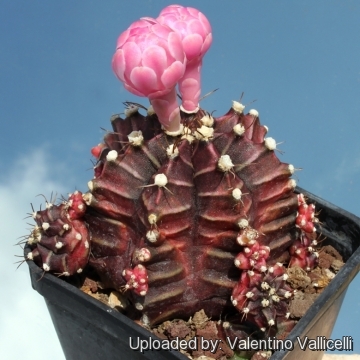 Gymnocalycium mihanovichii var. friedrichii f. Rubra (Gymnocalycium mihanovichii cv. Hibotan) Photo by: Valentino Vallicelli
Gymnocalycium mihanovichii var. friedrichii f. Rubra (Gymnocalycium mihanovichii cv. Hibotan) Photo by: Valentino Vallicelli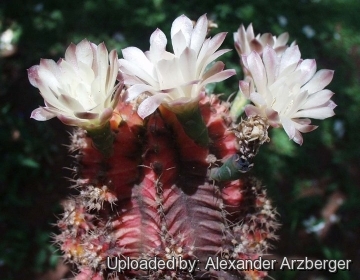 Gymnocalycium mihanovichii var. friedrichii f. Rubra (Gymnocalycium mihanovichii cv. Hibotan) Photo by: Alexander Arzberger
Gymnocalycium mihanovichii var. friedrichii f. Rubra (Gymnocalycium mihanovichii cv. Hibotan) Photo by: Alexander Arzberger Gymnocalycium mihanovichii var. friedrichii f. Rubra (Gymnocalycium mihanovichii cv. Hibotan) Photo by: Cactus Art
Gymnocalycium mihanovichii var. friedrichii f. Rubra (Gymnocalycium mihanovichii cv. Hibotan) Photo by: Cactus Art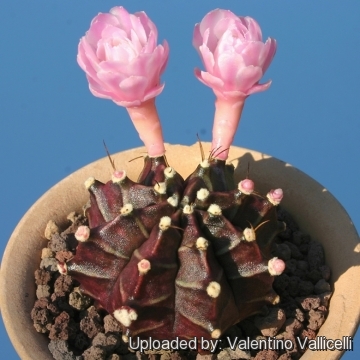 Gymnocalycium mihanovichii var. friedrichii f. Rubra (Gymnocalycium mihanovichii cv. Hibotan) Photo by: Valentino Vallicelli
Gymnocalycium mihanovichii var. friedrichii f. Rubra (Gymnocalycium mihanovichii cv. Hibotan) Photo by: Valentino Vallicelli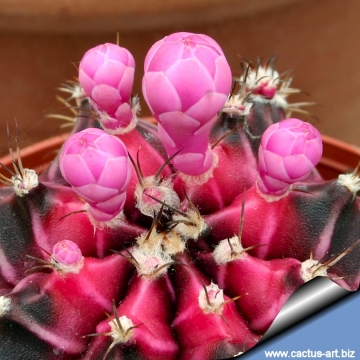 Gymnocalycium mihanovichii var. friedrichii f. Rubra (Gymnocalycium mihanovichii cv. Hibotan) Photo by: Cactus Art
Gymnocalycium mihanovichii var. friedrichii f. Rubra (Gymnocalycium mihanovichii cv. Hibotan) Photo by: Cactus Art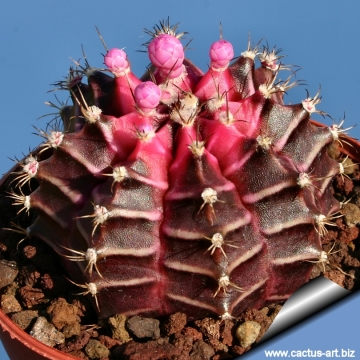 Gymnocalycium mihanovichii var. friedrichii f. Rubra (Gymnocalycium mihanovichii cv. Hibotan) Photo by: Cactus Art
Gymnocalycium mihanovichii var. friedrichii f. Rubra (Gymnocalycium mihanovichii cv. Hibotan) Photo by: Cactus ArtCultivation and Propagation: Variegated cacti are regarded as choice and difficult in cultivation, but despite that many of them are relatively easy to grow. They are sometime seen as grafted plants, but some forms grow well on their own roots, too. On the contrary, the albinos can survive only if grafted on a strong green base.
Soil: Use mineral well-permeable substratum with little organic matter (peat, humus).
Moisture needs: Water sparingly from March till October and keep perfectly dry in winter.
Fertilization: Feed with a high potassium fertilizer in summer.
Exposure: They cannot tolerate prolonged exposure to direct sun light (especially during the hottest summer days), so grow them in half-shade or under filtered sun.
Frost Tolerance: Overwinter this plants at temperatures from 5 to 15 degrees centigrade. In general these plants are more tender than standard gymnocalyciums and cannot endure freezing temperatures. In the rest period no high atmospheric humidity!!
Propagation: Plants are often grafted onto column-shaped cacti, but the forms with some chlorophyll can be reproduced by seeds or cuttings.

















